 |
| Stonehenge. |
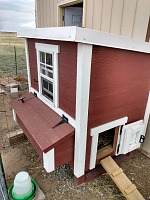 |
| Our new, tiny, luxury hen-house. |
It began with me taking too long to with winter order of plants from our
Conservation District, until I missed the whole deadline. Thus I looked for
another place where to buy or order trees and bushes, so that I had something
to plant on another portion of our prairie. In April I found myself shopping
in one of the local nurseries, where they told me that trees would arrive by
mid-May. Still I noticed that they were selling various rocks and stones and
similar things. Our driveway makes a loop around our well and its underground
tank, and pump. Yet the pump head is unfortunately stuck outside the central
ring, and consequently in the way of the next careless driver — and we
had been pondering for months how to mark or fence off the pump so that nobody
ploughs through it. We can't erect posts or plant trees this close to the tank,
and there are few surface options — those that our local wind won't take
away. Finally I took Sid to the nursery to help me pick decorative stones.
Besides stones, we noticed a hen-house at the nursery. A tiny one, allegedly
for only five chickens (we've got three), yet built very sturdily
(manufacturer is located in Montana, north of us, and apparently they know
something about "weather"), on skids, thus being "easily"
moved with a forklift, and apparently designed by someone knowledgeable about
chickens and their farmers. The hen-house has permanent vents, and an extra
windows that can be opened (extra venting on hot days); roosts, egg-laying
shelf accessible from outside, and both small door for chickens and a big door
for humans to make cleaning access easy. I started to think that an external
hen-house might come handy — we had acquired our birds in a hurry, and
they lived in the goat shed, inside our so far second attempt to integrate
space suitable for egg-laying chickens — but like all compromises, even
that coop in a pen was not ideal. It took space away from goaties, and chickens
too did not have their room and quiet. I got attached to the idea of
a hen-house — and so we purchased raffle tickets for this one.
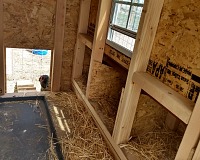 |
| Chickens approved this hen-house. |
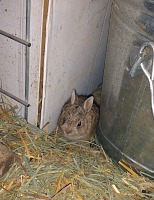 |
| We have a squatter in our goat shed. |
Stones arrived at the beginning of May; by mid-May I returned to the nursery to
deal about the trees — and still admired the beautiful hen-house —
and was hit by unwelcome news — the raffle would take place only in
OCTOBER. I left the nursery with a tree order placed, clutching a leaflet of
the hen-house manufacturer, because it started to be clear that even if
I happened to win the raffle, it would be too late, into winter. After a few
phone calls I found myself at the local distributor of said Montana company
— and bought a hen-house a bit larger than the raffled one. And I began
to eye longingly their sheds, for I also have a storage section inside the
goat shed, where I keep hay, and I could use an external one. I have to go
carefully though, for Sid is after all an older gentleman, and it could hit him
hard — first a hen-house, now a shed... just the coop cost so much that
we must hope our chickens will lay golden eggs — lest they never pay us
back.
On the other hand — our chickens seem to enjoy their new house. When
we used to remodel the goat shed, I always had to carry them and set up to
their new place, because they did not understand it. Now they marched into
their new house without hesitation, and began laying eggs in their new boxes.
Apparently the hen-house is built so well, even a chicken gets it.
I've got on more chicken story. I wondered why, during our walks around the
prairie with goats, the chickens follow me and keep close to my leg like
well-trained dogs. Until I noticed instances when they leave the
"heel" position — that is, jumping out to snatch a beetle or
a butterfly, which I spook out of the tall grass — they use me as
a bush-whacker!
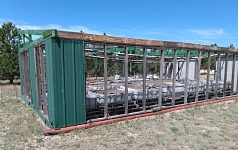 |
| Wyomese wire-house. |
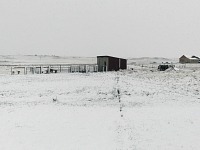 |
| ...is useless when it snows at end of May. |
Now that I mentioned using someone — our court bunny Jackie had a bunch
of young again — apparently somewhere in the compost — my
construction from pallets offers many a hidey-hole — whilst I turned the
compost over, I nearly forked a tiny rabbit. It did not get fazed, and now that
I brutally evicted it from the compost, it found accommodation with our goaties
in their shed. When I found it there the first time, munching on hay inside a
nicely warm shed on a frosty morning, I though it an accident. A few days later
I enjoyed seeing nothing had eaten it yet (small bunnies don't last —
we have owls, coyotes and hawks), and that it has to be a very clever bunny,
when it manages to find shelter with the goaties. Since then Bobby became
member of our menagerie, and we can see it practically every day — either
right inside the shed, or grazing around — and if you pay attention, it
can be spotted sleeping somewhere.
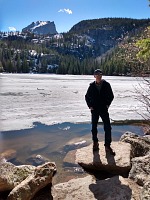 |
| Tom at Bear Lake. |
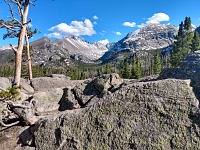 |
| A view above Nymph Lake |
Along the plant front I can report that trifids are thriving — wasteland
under our basement turned nicely green, when trifid toddler stopped
camouflaging as brown. This encouraged me to sow more of the seeds into random
bald spots. And since I had no ripe compost left, I fertilized it with goat
pellets. Unlike horse or chicken manure, goat droppings aren't caustic, even
fresh. So says theory; practice seems to confirm it — or perhaps trifids
are quite hardened and would grow anywhere.
Furthermore I invited myself to our friends Doris and Brayn to check out their
veggie patch. Growing something in local conditions (6,000 feet altitude, wind,
arid climate, peppered with storms and hail) is not easy. Last snow comes on
Mother's day (second Sunday in May) and first snow of next winter can be
expected by mid-September — thus only plants with vegetation cycle of
up to ninety days make sense. A glass-house won't help you much, as it gets
routinely blown away by wind or shattered by hail. Hot-houses get built from
durable plastic, or as wire-houses. Wire mesh instead of glass protects your
produce from largest hail stones — and rabbits. As much we consider
Bobbie and Jackie members of our ranch, I am fully aware of the destructive
potential of these cute rodents. Another trick to deny rabbits access is
elevating plants into above-ground trays — this has the advantage of
keeping ground squirrels from digging to the roots. The few remaining farmer's
enemies are: birds, mice, ants, aphids, caterpillars, fungi and various plagues
— and weather.
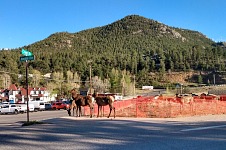 |
| Wild animals abandoned the National Park and seeks culture in the city. |
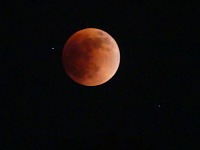 |
| Eclipse of the Moon. |
Before I conclude that I had totally buried myself in our property, be aware
that we also toured the wide world — namely, Colorado. And right one of
the famousest of National Parks — Rockies. We had arranged a sleep-over
at Karel's place, a climbing friend whom we still have not met in person.
The plan was simple — we would leave home by morning, have lunch in
an Indian restaurant in Forth Collins where they make dosas — rice flour
crepes stuffed with cheese or masala — that I like and can eat as they
don't contain gluten. For the afternoon we expected to reach Karel's place,
settle in, discover where to go for dinner and so on. If you can't spot the
fault in such plan, know that we did not either. After touring for twenty years
to Sierra Nevada we are programmed to allot three to five hours to driving into
the mountains, and so we counted subconsciously on spending the afternoon in
the car. Even having stopped for lunch, we unlocked Karel's door by two p.m.
I'm not complaining, for it was a pleasant mistake, since we could fit in an
afternoon visit to the Park. We tried to ask a ranger where to hike in those
few hours left of the day. He answered in a flat voice and it was obvious he
had had enough on this Sunday afternoon. He recommended Bear Lake, so we tried
it. A loop around the lake was pretty, but crammed with people — and too
short. So we embarked to Nymph Lake. Our hike got complicated by snow —
there were bald spots and air temperature supported shorts and and a t-shirt
— and then in shady stretches there was knee-deep snow. But even I
managed it, wearing tennis shoes.
Lures of a picturesque town of Estes Park worked for us again — while
tourists in the National Park gathered around every squirrel, real wild life
in the shape of imposing elks arrived on Main Street by the evening.
During our last visit we spotted massive Chuck the elk, and this time we were
not surprised, until we encountered a beaver splashing in a pond right next to
Karel's house. Now we're afraid Karel may charge for safari.
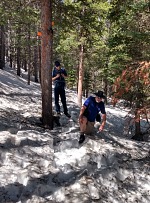 |
| Legolas balances on top of a snow bank into which hippos plunge. |
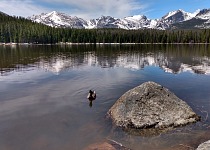 |
| Bierstadt Lake. |
We reserved all Monday for the Park. Having rifled through Karel's guide books,
I found a recommendation for a trail to Bierstadt Lake — which can be
reached either via switchback from the road, ascending a considerable
elevation through a moraine — or by following a longer, but somewhat more
comfortable ridge from Bear Lake. Well, that route was truly longer, but mostly
because most of it consisted of stumbling through three feet of snow-bank.
Plunging in butt-deep was often embellished by a spring brook bubbling right
underneath. Weather was still good for shorts, but tennis shoes proved truly
sub-optimal. After about two hours of cursing we finally arrived to a beautiful
mountain forest lake. I wrung my socks and shoes, and let them dry on
a boulder, we ate a snack and wondered what to do. Tourist who had reached the
lake over the steep moraine trail, reported it to be completely dry; it would
make sense leaving that way. Yet — we had left our car parked up at
Bear Lake.
Our Legolas — Tom — came to our rescue. He would not plunge into
the snow-banks with his (under)weight like we did, and our group must have
looked indeed like from Lord of the Rings, where all wade through deep snow,
while elegant elf walks on top. Tom agreed to return across all that snow
to Bear Lake and drive the car under the moraine — while his elderly
parents descend with dry feet.
Elderly parents felt a bit guilty, especially since on our way down we had
a marvelous view of mountain peaks. We were also a bit afraid, since clouds
gathered over some of the slopes, and Tom could get caught in a storm or
blizzard. We ran down rather briskly, counting on having to wait for our lift
for an hour or two — but Legolas truly had to fly over the snow, as he
arrived, car and all, only a fifteen minutes later. He did not fully state so,
but apparently hiking without impossible, huffing geezers, goes much better
and faster.
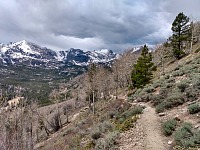 |
| Clouds gather overhead. |
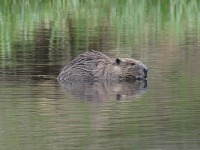 |
| Expecting safari surcharge... |
We got back to Karel's — advantage of a house over a hotel room is in not
having to check out in the morning — this way, we easily packed in the
afternoon, showered, changed, cleaned up a bit, and made it back home in
a civilized time — clean, fed and recreated.
We looked forward to returning soon to these mountains — with much
of the snow melted away, trails better accessible — but it snowed
again on twentieth of May. The following Memorial Day (a three day weekend at
the end of May, when most people venture outdoors) it snowed again. Even the
responsible farmers who waited with planting till the last moment, lost
tomatoes and other sensitive plants. Tourists and vacationers had to scramble
their plans of camping and recreation (while the tough ones, unlike us,
certainly did not get distracted by crazy cold or snow). We got disrupted in
our plans for the social occasion of the year — Tom's graduation.
In last moment I looked for pantyhose and petticoat under my dress —
as I have not possessed these garments fore years (i.e., we lived for twenty
years in California) — and snow was forecast.
 |
| Tom's graduation. |
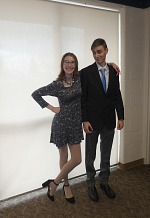 |
| Siblings. |
In general, once one matures to a certain age, then despite somehow fitting in
a dress worn twenty years earlier, there's a risk of projecting the image of a
menopausal sprite. I was facing a complex wardrobe puzzle, only to discover
on the night before the graduation that I best looked in a black night-gown,
which reaches down to my knees, with a few silver accessories and shoulders
covered with a red sweater. It looked quite decent formal attire. But if you
expect a picture of Carol in night-gown here, you'll be disappointed —
nobody took my picture during the whole graduation. The event took place in a
borrowed auditorium built in (and not remodeled since) the sixties, with
inadequate lighting and most likely original carpets and wallpaper in the color
of feline vomit. Thus we resolved to take our pictures rather outside, lacking
the background of piled collapsible chairs and plastic tables, fire
extinguishers, restroom entrances. But when we emerged outside, there was
a snow shower going on and so we hurried into our car as fast as we could.
Back to the event itself — since the remote school that our children
attend, officially operates out of the small town of Lusk (population: fifteen
hundred!), it took place there — some two and half hours drive away.
We went attired casually, expecting to change there, and so it happened that
I forgot my petticoat and could not even wear my pantyhose, and went with bare
legs and feet in midst of that snowing. Eventually, though, I was glad to wear
fewer layers, for after two hours in the auditorium we were all stewing in our
own juices.
Yet we did not have time to think about it — the affair moved at
a surprisingly fast pace — and most importantly — keynotes were
very, very interesting. They should not be; in a normal world, a statement
that a school is supposed to teach people to think for themselves, should not
be a revelation; we do not live in a normal world or time. Here we are, four
hundred years after a sweeping educational reform of European civilization,
we're ecstatic when someone elevates thinking over parroting, and lecture
over indoctrination.
It would seem then that we had improved ourselves by moving in many more
aspects — even those where we had lost hope of improvement.




















